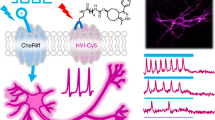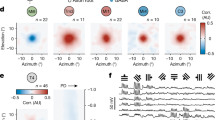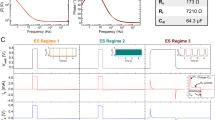Abstract
Neurones in the intact retina are interconnected by a complex network of chemical and electrical synapses. The electrical interactions between many types of retinal neurones make it difficult to determine the active and passive membrane properties of the individual cells. A direct way to examine such properties is to dissociate the retina into single cells1–3 and to record intracellularly from identified, isolated neurones in the absence of neural connections. Such an approach has been used to study the electrophysiological properties of several classes of neurones in the vertebrate retina3–5. We have combined the method developed previously for examining the neurochemistry of individual retinal cells1,2 with a single-electrode clamp technique6,7 to investigate the biophysical properties of isolated horizontal cells from the teleost retina. Our results suggest that the specific membrane capacity of these cells is ∼1 µF cm−2, and that the specific membrane resistivity ranges from ∼5,000 to 20,000 Ω cm2. In isolation, these cells can show regenerative voltage responses which are most probably calcium-dependent.
This is a preview of subscription content, access via your institution
Access options
Subscribe to this journal
Receive 51 print issues and online access
$199.00 per year
only $3.90 per issue
Buy this article
- Purchase on SpringerLink
- Instant access to full article PDF
Prices may be subject to local taxes which are calculated during checkout
Similar content being viewed by others
References
Lam, D. M.K. Proc. natn. Acad. Sci. U.S.A. 69, 1987 (1972).
Lam, D. M.K. Nature 254, 345–347 (1975); Cold Spring Harb. Symp. quant. Biol. 40, 571–579 (1976).
Drujan, B. D. & Svaetichin, G. Vision Res. 12, 1777–1784 (1972).
Kaneko, A., Lam, D. M.K. & Wiesel, T. N. Brain Res. 105, 567–572 (1976).
Bader, C. R., Macleish, P. R. & Schwartz, E. A. Proc. natn. Acad. Sci. U.S.A. 75, 3507–3511 (1978).
Johnston, D., Hablitz, J. J. & Wilson, W. A. Nature 286, 391–393 (1980).
Johnston, D. Cell. molec. Neurobiol. 1, 41–55 (1981).
Naka, K.-I. & Carraway, N. R. G. J. Neurophysiol. 38, 53–71 (1975).
Lam, D. M.K., Lasater, E. M. & Naka, K.-I. Proc. natn. Acad. Sci. U.S.A. 75, 6310–6313 (1978).
Hagiwara, S. in Membrane—A Series of Advances Vol. 3 (ed. Eisenman, G.) 359–381 (Dekker, New York, 1975).
Akaike, N., Lee, K. S. & Brown, A. M. J. gen. Physiol. 71, 509–531 (1978).
Cole, K. S. Membranes, Ions and Impulses (University of California Press, Berkeley, 1968).
Brown, T. H., Perkel, D. H., Norris, J. C. & Peacock, J. H. J. Neurophysiol. 45, 1–15 (1981).
Kaneko, A. J. Physiol., Lond. 213, 95–105 (1971).
Author information
Authors and Affiliations
Rights and permissions
About this article
Cite this article
Johnston, D., Lam, DK. Regenerative and passive membrane properties of isolated horizontal cells from a teleost retina. Nature 292, 451–454 (1981). https://doi.org/10.1038/292451a0
Received:
Accepted:
Issue date:
DOI: https://doi.org/10.1038/292451a0
This article is cited by
-
Cable theory in neurons with active, linearized membranes
Biological Cybernetics (1984)
-
Differences in the kinetics of rod and cone synaptic transmission
Nature (1982)



